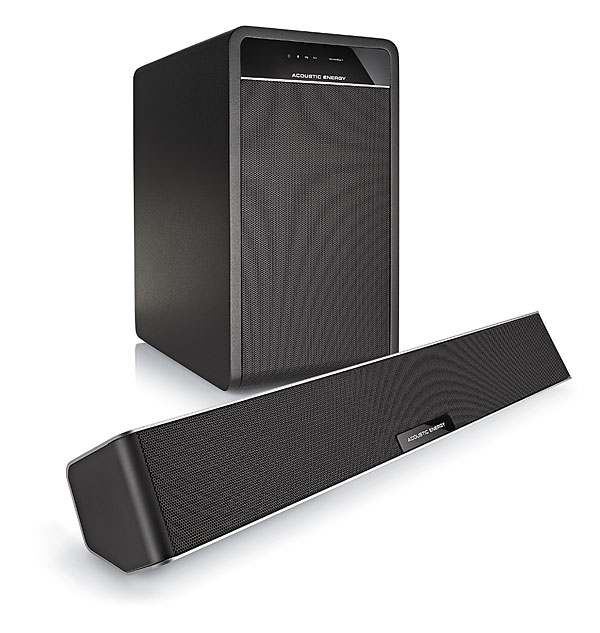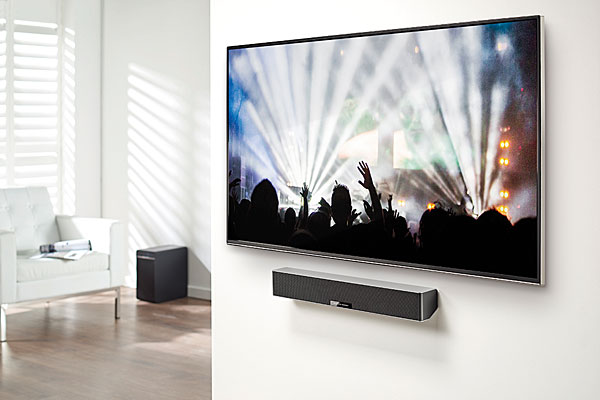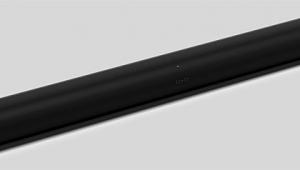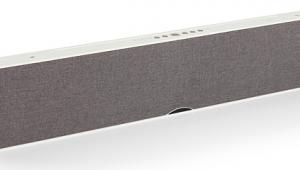Soundbars on a Budget Acoustic Energy Aego Sound3ar

Acoustic Energy Aego Sound3ar
PRICE $400
AT A GLANCE
Plus
Superb sound quality
Compact, stylish form factor
Dynamic and loud
Minus
No HDMI
No virtual surround
All amplifiers contained in sub
No IR learning
THE VERDICT
Among soundbars, it doesn’t get any more no-frills, nor much more musical, than Acoustic Energy’s Aego Sound3ar system.
It’s been a while since Acoustic Energy, a British loudspeaker manufacturer that has reviewed well with us in the past, has had a U.S. presence. That’s ending now thanks to the brand’s import by high-end audio specialist Essence. The Aego Sound3ar is one of two products in the Aego line, the other being the Aego3, which is, like this, a 2.1-channel system with a powered subwoofer but with a pair of cube monitors in place of the bar.
The Aego is not highly featured by today’s standards. There’s an aptX 4.0 Bluetooth input for wireless, but the system elements remain decidedly tethered: the subwoofer to your source, which must be wired directly via the single optical digital or 3.5mm analog stereo minijack input on the sub’s back panel, and the subwoofer to the passive soundbar, which gets its speaker-level signals from amps in the sub via a pair of RCA connectors. Having only one digital input means you’ll likely use your TV as the source switcher and funnel its optical audio output to the bar. The Aego has no Dolby or DTS decoder and accepts only PCM on its digital input.
 The compact bar, just 19.75 inches wide and 2.75 inches tall, is well crafted from a piece of wrapped brushed aluminum, rubber end caps, and a black metal grille. It houses a single 1.77 x 2.17-inch full-range paper cone driver for each channel and has five sides to allow for a bottom that cants the front face up by about 30 degrees to help disperse sound into the room. If you mount it on the wall, the baffle faces straight ahead.
The compact bar, just 19.75 inches wide and 2.75 inches tall, is well crafted from a piece of wrapped brushed aluminum, rubber end caps, and a black metal grille. It houses a single 1.77 x 2.17-inch full-range paper cone driver for each channel and has five sides to allow for a bottom that cants the front face up by about 30 degrees to help disperse sound into the room. If you mount it on the wall, the baffle faces straight ahead.
The subwoofer is a rectangular slab with black textured finish that stands not quite 14 inches tall, and contains a 6-inch rear-firing paper cone woofer on the back and 6x9-inch oval passive radiator facing front. There’s a 65-watt RMS amp for its 6-inch driver and a 25-watt amp for the bar. Since it houses the remote sensor, it’s meant to be placed up front. It’s made of reasonably solid wood MDF construction rather than the typical molded plastic.
The supplied IR remote is a tiny card design not much bigger than a pack of chewing gum and equipped with membrane blister buttons—the type of remote that quickly seeks the quiet and damp crevasses between your sofa cushions. It offers direct input buttons and bass control along with volume and mute, but there are no faux surround or EQ modes. And there is no routine for teaching the bar the IR codes from your TV or cable remote. Its operation can be assigned to a universal remote, or maybe your TV’s optical connection can be set to variable output so it swings up and down with the TV volume rocker.
Music
I’ll start with the negs here to get them out of the way. The Aego’s biggest sonic fault is a restricted soundstage that is undoubtedly endemic to the physics of the positioning of tiny drivers placed less than 2 feet apart. This is where phasey-artifact-inducing digital processing usually comes in on most soundbars in an attempt to spread things out. Without these crutches, the Aego mustered a front image that went a bit wider than the bar at my 9-foot distance but well short of the edges of my narrow room, and a soundstage height that was just reasonably tall. Depth was modest at best. The bar was also intolerant of off-axis listening, shifting tonality even with relatively small movements right or left.
Beyond this, I was pleasantly sur- prised, even blown away, by what proved to be the very serious audiophile chops this tiny soundbar brought to the table. Track after track, the Aego put forth a level of detail, dynamics, and tonal balance that raised my pulse and kept me coming back for more. Big drum-heavy tracks like Mayer’s “Gravity” were delivered with impact instead of fizzle, despite a subwoofer that the test tones showed was concentrating its output around 100 Hz in my room and dropping off below 60. The triangle dings in “I Remember You” came through with a combination of delicacy and elongated decay reminiscent of fine audio systems. That led me to Pink Floyd’s “Time” from The Dark Side of the Moon SACD and all those opening bells and that driving bass track and heartbeat, and on to the Dixie Chicks doing the Celtic-tinged “Bitter End” from Taking the Long Way, where all manner of detail in the fiddling and banjo-picking were easily delineated from the rest of the busy mix. The Aego even managed to successfully capture the dynamic swells of the strings in Tchaikovsky’s “Hopak from Mazeppa” from Reference Recordings’ Exotic Dances of the Opera—though it came up short in communicating the spaciousness of the hall and the gutteral depth of the tympani, and finally became stressed on the most energetic passages played at admittedly too-high volume. Bottom line: I could have listened to music all night long on this thing. And I did.

Movies
The clarity and dynamics the Aego demonstrated on music were welcome companions for movie and TV viewing, and the system offered emotional engagement, but with the expected limitations. Leading bass transients had sharpness, and bass generally had good definition and slam; the Aego handled the rumbling engines in Max with finesse but couldn’t reach low enough for sustained visceral impact. The system played fairly loud, reaching 89 dB at my listening seat on my steady-state pink noise measurements, although I maxed out the volume on occasion, suggesting this is a system best suited for smaller rooms. In any event, it never allowed itself to be driven into serious distortion. In Chapter 5 of the Pixar-animated Inside Out, musical elements like a brief accordion riff and Foley effects like the dropping and rolling of Riley’s core memories (which look, and sound, like marbles), or the creaking and groaning of collapsing metal machinery that constitutes one of her “personality islands,” had lifelike realism. Unfortunately, the relatively narrow front stage and lack of any surround or spatial effects here was disconcerting, though in the absence of knowing what’s missing, one might not feel the same way.
Conclusion
With Acoustic Energy’s compact Aego Sound3ar, you’ll sacrifice some soundstaging, spaciousness, and special effects, things you might genuinely miss on soundtracks. But what it delivers, it does so with an honesty and musicality uncommon among soundbars. If you expect to spend as much or more time listening to music as you will watching movies, this one will capture your heart.
- Log in or register to post comments





































































